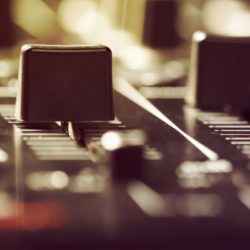Yesterday, we covered how to get tracks ready for a studio mix. We used Traktor and Mixed In Key to prepare our music, and today we will be completing the process using Ableton Live. If you haven’t read Part 1 of this tutorial, I suggest doing so before continuing any further.
Once the cue points are assigned, I start Ableton Live and load my songs in to be mixed. When I start this process, I normally have a good feel for the order and placement of each song being used in the mix. Included below is a link to a blank template I use when starting my mixes in Ableton.
Download the Ableton Mix Template. You must have Ableton 9.1 to open the file.
BPM & Warping
When preparing songs for mixing in Ableton, you will first need to “warp” the song and enter in the original BPM. To warp in Ableton Live, find the first beat of the first measure of the song. You may see a grey marker above this beat, if so, click until it turns yellow and then right-click. When you right-click the marker, select the option “Set 1.1.1 Here.” Then right-click the marker again and select “Warp From Here (Straight).” Finally, select “Complex Pro” and enter the original BPM of the song in the “Seg. BPM” section.
Once your songs have been properly set up, start mixing them together. If I am unsure of where I should be lining the songs up, I often use the visualization of the wave to see when the audible breakdowns and build-ups are in each song. Using this method allows me to set a song to start as another is fading out. See below for an example.
FX Rack For Mixes
One of the best features of Ableton Live are its on-board effects. Ableton’s selection of delays, reverbs, EQs and other various effects give a great deal of power to shape and sculpt the sounds you are using. I have included a rack of effects in the template that I use on every channel of my mixes. The effects featured are EQ Three, Low Pass Auto Filter, High Pass Auto Filter and Utility.
I use the EQ Three just like I would a regular DJ EQ. One of the main reasons I use EQ Three is its easy use of the cut-off buttons. I regularly use the Low-Cut for mixing in or out of songs that need a little room. I have two Auto Filters set to the FX rack. On the left is a Low Pass Filter, which turns on as soon as the knob is automated. The right filter is a High Pass and turns on as soon as the Frequency knob on the FX rack is turned the opposite direction. Last, I use the Gain knob on the Utility plugin to automate all of my volume changes. I do this so that I can use the volume fader on each channel to control the overall volume of each song.
For finishing touches, I usually add a simple little delay or reverb to songs which might have an abrupt ending and need to carry on a little. To cut down on processing power, I usually set up two “sends” that allow a signal to send to the effect, and then the effected signal gets sent back to the master channel. This is referred to as a send/return. I have set these up in the Ableton template for use in the mix.
Mastering
When you’re ready to render your mix, do a little mastering to ensure it sounds good in every listening environment possible. Mastering is a VERY involved process, which takes years to get your ears and head around. I could write a ten-part series just on that topic alone. That being said, I have included a slight mastering chain on the master channel of the template that will help your mix sound better. You will simply need to turn the chain on, and turn the Limiter Gain knob up on the FX rack until you see the limiting begin. Once you do, turn the knob slightly back from where it was set. This will make your mix louder, without sacrificing its integrity. It is best to keep whatever is done at this stage to a minimum. Most music put out these days has already been mastered, so doing more work to it could be overkill.
Using all of the tools I have included in the template, you should have all you need to create a solid studio mix. But I highly recommend getting creative by inserting different effects into the chain I created, or better yet, try using a completely different chain. Doing studio mixes is a great way to get to know the Ableton Live software because it deals with the basic functions of Ableton. Many people make the transition to full audio production after doing their first mix on Ableton Live.










Join the discussion
comments powered by Disqus